- Home
- Hermann Hesse
Soul of the Age
Soul of the Age Read online
The author and publisher have provided this e-book to you for your personal use only. You may not make this e-book publicly available in any way. Copyright infringement is against the law. If you believe the copy of this e-book you are reading infringes on the author’s copyright, please notify the publisher at: us.macmillanusa.com/piracy.
Contents
Title Page
Copyright Notice
Introduction by Theodore Ziolkowski
Correspondence: 1891–1962
Notes
Selected Bibliography
Index
Copyright
INTRODUCTION
Hermann Hesse was an inveterate letter writer. In the eighty years between a note that the four-year-old dictated to his mother in 1881 and the thank-you note that he mailed to a colleague shortly following his eighty-fifth birthday in 1962, he wrote over thirty thousand letters and cards to hundreds of correspondents. Hesse was seemingly incapable of leaving a communication unanswered. In 1934 he observed that “for many years approximately half of my work has consisted in reading and answering the letters that I receive from Germany”—a responsibility that, until 1950, he carried out personally. And although later—especially following the award of the Nobel Prize in 1946, when he received more than seven thousand letters—he often responded with circular letters or acknowledgments printed for special occasions, he took it as a moral commitment to reply to every communication.
This epistolary impulse merits our attention not just, or mainly, because of the impressive output it engendered. When Hesse was still in his teens, his father noted this compulsion in a letter to Hesse’s sister Adele. “He writes remarkably many letters. His correspondence evidently compensates for something else.” In this sense the letters suggest a compulsive need for communication. But the fact that so much of his intellectual and spiritual energy went into letters rather than literary works suggests yet another dimension of meaning.
Hesse refused to establish a firm line between his life and his literary works. “If you regard literature as confession—and that’s the only way I can regard it at present,” Hesse confided in his “Diary of 1920,” then art amounts to the effort to express as fully as possible the personality of the artistic ego. “I gave up all aesthetic ambition years ago,” Hesse confessed in the same spirit to a correspondent in 1926, “and no longer write poetry but simply confession.”
Given this pronounced confessional tendency, it is surprising that Hesse undertook no real autobiography—especially since he was a fan of literary biography and developed detailed (though ultimately unrealized) plans to edit a series of classic German autobiographies. However, writings of a generally autobiographical nature occupy an increasingly important place in his oeuvre. During the twenties Hesse produced a number of brilliant autobiographical essays, including “A Guest at the Spa” and “The Journey to Nuremberg.” During the two decades between the publication of The Glass Bead Game (1943) and his death in 1962 Hesse wrote no further “fiction” as such, but he turned out a steady stream of autobiographical accounts ranging from reminiscences of childhood (“For Marulla”) to notes on a summer vacation (“Events in the Engadine”). (Many of these pieces have been collected in the volume Autobiographical Writings.)
Hesse’s obsession with autobiography was motivated by the symbolic view he held of his life. When Hugo Ball was commissioned by the publisher S. Fischer to write a biography to commemorate Hesse’s fiftieth birthday, Hesse wrote to him (October 13, 1926): “If a biography of me makes any sense, it is probably because the private, incurable, but necessarily controlled neurosis of an intellectual person is also a symptom of the soul of the age [Zeitseele].” The letters represent not only an act of communication with others but also a continuing record of Hesse’s own life—the raw materials underlying both his fiction and the artistically shaped autobiographical writings. In his letters we have the best account of the process of individuation that he attempted to portray symbolically in his novels—the integration of identity that leads, through disillusionment and crisis, by way of analysis, to a sense of unity and cosmopolitanism. In his letters, which are characterized by a relentless honesty, we have the best access to Hesse’s intellectual and spiritual world as well as a lively account of the social world in which he lived and the European history that he witnessed.
* * *
Hesse came by his confessional epistolary impulse naturally. The preoccupation with incessant self-scrutiny and confession is one of the hallmarks of the Pietism that dominated the spiritual life of that section of Europe in which he spent the first thirty-five years of his life: essentially, that corner of Germany and Switzerland between Basel and Stuttgart where people speak the Alemannic dialect that characterized Hesse’s own speech. Hesse’s maternal grandfather, Dr. Hermann Gundert (1814–1893), was a Swabian Pietist who spent twenty-four years in the service of the Basel Missionary Society on the Malabar Coast of India. Soon after his return to Europe in 1859 he became director of the Calw Missionary Press, one of the leading German publishers for the dissemination of theological writings. Gradually recognized as one of the leading European authorities on India, he continued his missionary efforts through such publications as a standard Malayalam grammar and a Malayalam-English dictionary as well as translations of the New Testament and parts of the Old Testament into Malayalam. His daughter Marie (1842–1902) married the missionary Charles Isenberg (1840–1870) and bore two sons, Theo and Karl, before she returned to her father’s house in Calw following her husband’s early death. Hesse’s father, Johannes Hesse (1847–1916), was a Baltic German from Estonia who spent four years as a missionary on the Malabar Coast before he was compelled for reasons of health to return to Europe. There he was reassigned by the Basel Missionary Society to assist Dr. Gundert in Calw, where he met Gundert’s widowed daughter, whom he soon married.
Marie, like her father, was a tireless writer who, in addition to letters and diaries, also turned out four popular books—including a biography, David Livingstone, the Friend of Africa—for the series “The Calw Family Library.” Johannes published fifteen books on edifying subjects, ranging from stories based on his experiences in India to training tracts for missionaries and admonitions to “slaves of masturbation.” It was into this family of incessantly writing Pietists, who filled their letters, journals, and books with ceaseless self-scrutiny, that Hermann Hesse was born in Calw on July 2, 1877, the second of four siblings: Adele, Hermann, Hans, and Marulla. Because the family never discarded any of the paper that they filled so compulsively with their perceptions and accounts, we have an unusually detailed record of Hesse’s early years.
As early as 1881, when his father adopted Swiss citizenship and moved to Basel to teach at a school run by the Basel Missionary Society, Hermann’s “violent temperament” was causing his parents great distress, as his mother noted worriedly in her diary. In June of 1883, Grandfather Gundert wrote to Johannes and Marie that “you must have a great deal of patience with Hermann,” consoling them with the thought that “it comes from God that our children give us puzzles that make us stand still in perplexity.” But only five months later Johannes wrote that Hermann, though a model of virtue at school, was often incorrigible at home. “As humiliating as it would be for us, I sometimes think very seriously that we ought to turn him over to an institution or to someone else’s care.” Matters improved in 1886 when the family returned to Calw, where his father soon took over the Missionary Press from Grandfather Gundert, who remained until his death a powerful presence in young Hermann’s life.
When he was twelve, Hesse was packed off to Rector Bauer’s Latin School in Göppingen to prepare himself for the regional examinations that constituted the entry barrier to the famou
s Württemberg school system in which generations of Swabian intellectuals, including the poets Hölderlin and Mörike and the philosophers Schelling and Hegel, had been educated. As a prerequisite for this free education, Hesse, alone among the members of his family, had to renounce his Swiss citizenship and become a citizen of Württemberg—a move that was to cause considerable difficulty for Hesse during and after World War I.
During the year and a half at Göppingen, later portrayed in his novel Beneath the Wheel, Hesse applied himself so diligently that he was among the privileged few who passed the examinations in the summer of 1891. He entered the seminary at Maulbronn, a beautifully preserved Cistercian monastery that was later to provide the setting for his medieval novel Narcissus and Goldmund. At first he responded enthusiastically to new friends and the excellent classical education offered to the aspiring young theologians and academicians. But within a few months the hyperactivity that had traumatized his parents reasserted itself. In March 1892 he ran away from school and had to be brought back by officers of the local constabulary. This episode was the prelude to such a severe fit of depression that in May his distraught parents withdrew him from Maulbronn.
For the next year and a half the future Nobel Prize winner was sent from one institution to another. First his parents turned him over to Christoph Blumhardt, a noted exorciser in Bad Boll, who tried to pray him back to health, with the perhaps not surprising result that the troubled youth tried to commit suicide—the first of several attempts. Next he was sent to a home for weak-minded children in Stettin where, as part of his treatment for “moral insanity,” he worked in the garden and tutored less able classmates. Following a third abortive attempt, at a school in Basel, Hesse attended the Gymnasium in Cannstatt, where he managed to obtain a certificate of educational proficiency in July 1893. At that point Hesse, insisting that his only wish was to become a writer, persuaded his weary parents to take him out of school, and thus at age sixteen he ended his formal education along with all hope of following the traditional family footsteps into a theological or missionary career.
Initially Hesse signed on as a bookdealer’s apprentice in Esslingen, but after three days ran away again and returned to Calw, where for half a year he scandalized the neighbors by his presence and his wild plans to emigrate to Brazil. From June 1894 to September of the following year Hesse settled down to the job of filing gears as an apprentice in Heinrich Perrot’s tower-clock workshop in Calw, an experience that gave him a sympathetic insight into the mentality of the town and country folk who populate his early stories.
Finally Hesse seemed to find himself. Signing on as an apprentice in Heckenhauer’s bookstore in the university town of Tübingen, he remained in the position for the four years necessary to receive his apprentice’s letter. Moreover, his dream of becoming a writer began to materialize. His first poem was published in 1896; he found a coterie of compatible friends who styled themselves the petit cénacle—Ludwig Finckh, Otto Erich Faber, C. Hammelehle, and others mentioned from time to time in his letters; he devoted himself intensively to the study of German literature, especially Goethe and other writers of the Romantic age; and his first volume of poetry appeared late in 1898 under the revealing title Romantic Songs. Hesse’s correspondence with the writer Helene Voigt, the fiancée of the young publisher Eugen Diederichs, paved the way for the publication of his prose sketches An Hour beyond Midnight (1899). In September 1899, with his letter of apprenticeship in hand, Hesse moved to Basel, where he worked in Reich’s bookstore until January 1901 and then, until 1903, in Wattenwyl’s antiquarian bookstore. In this city dominated by the memory of the philosopher Nietzsche and the cultural historian Jacob Burckhardt, Hesse was introduced to a sophisticated circle of artists and intellectuals in the home of city archivist Rudolf Wackernagel. Meanwhile, he began to establish his own literary reputation with articles and reviews in Swiss newspapers and journals. Although his mother had disapproved of his Romantic Songs, which she considered immoral, Hesse hoped to win her approval with the volume Poems, which he dedicated to her in 1902. Unfortunately, she died shortly before their publication, yet Hesse—in the curious ambivalence that characterized so many of his family relations—did not even make the short trip to attend her funeral.
With the distance afforded by his new surroundings, he came to grips ironically with the years of his Tübingen bohème in The Posthumous Writings and Poems of Hermann Lauscher (1901). The work, though published at his own expense, was impressive enough to interest Samuel Fischer, the enterprising publisher who was building up one of Germany’s most exciting presses. Hesse’s next novel, Peter Camenzind, which S. Fischer published in 1904, was an immediate success that brought Hesse international recognition, prizes, and his first financial independence.
In the course of a trip to Italy in 1903 Hesse had met Marie Bernoulli (1869–1963), a professional photographer from the distinguished family of Swiss mathematicians. Over the objections of her father, Hesse married the talented but moody young woman who went by the name of Mia and, nine years older than Hesse, already betrayed the melancholy that was to lead within a few years to severe emotional disturbances. (It is worth noting that both his grandfather Gundert and his father had married older women; Hesse was following an established family pattern. And it is probably no accident that, a year following his mother’s death, he was attracted to an older woman who bore her name.) Mia found an old peasant house without gas, electricity, or plumbing in the village of Gaienhofen on the shore of Lake Constance—a community so isolated that Hesse had to row across the lake even to buy household necessities. Here, in the course of the next eight years, the new couple built a larger and more comfortable house to accommodate the three sons—Bruno (1905), Heiner (1909), and Martin (1911)—who gradually enlarged the family. Less and less secluded in the village that was rapidly transforming itself into an artists’ colony, they received frequent visits from writers and especially the musicians—Othmar Schoeck, Fritz Brun, Ilona Durigo, Alfred Schlenker, and others—whom Hesse had met through the mediation of his musically gifted wife.
Meanwhile, Hesse’s literary career thrived. He finished his schoolboy novel Beneath the Wheel (1906), and his musicians’ novel Gertrude (1910), while turning out the dozens of popular stories and poems that were incorporated into commercially successful volumes with such titles as In This World (1907), Neighbors (1908), On the Road (1911), and By-Ways (1912). Stimulated by frequent trips to Italy, Hesse wrote biographies of Boccaccio and St. Francis of Assisi (both 1904). He began a busy career as a book reviewer, which eventually produced over three thousand reviews during his lifetime. He contributed to the satirical weekly Simplicissimus, whose editor, Reinhold Geheeb, had become his friend in 1906. With Ludwig Thoma, Hesse was a founding editor of the liberal-oppositional weekly März (1907–1912).
Yet for all these external signs of success—or perhaps precisely because of them—Hesse was chafing inwardly at the thought that he had become simply another member of the bourgeois society of imperial Germany that he detested. At first his dissatisfaction manifested itself in the increasingly frequent trips that took him away from Gaienhofen for weeks at a time—to the alternative community of “nature healers” at Monte Verità near Ascona (1907), for “nude rock climbing” on the Walensee (1910), on lecture trips through Germany and Austria, and annual tours to Italy with various friends. His nomadic urge was not satisfied by these relatively short excursions. In September 1911—barely a month after the birth of his third son—Hesse embarked on the North German Lloyd steamer Prinz Eitel Friedrich on a three-month voyage to the East with the painter Hans Sturzenegger. Hesse imagined this trip as an archetypal return to family origins and to the mysteries of the Orient represented by his “Grosspapa” Gundert. In fact, though he climbed the highest mountain in Ceylon (present-day Sri Lanka), explored Singapore, and visited Sumatra, Hesse never set foot on the subcontinent itself or the Malabar Coast where his grandfather and both his parents had been active. And, as h
e admitted in a letter to his friend Conrad Haussmann (November 1911), he did not find a people of paradise but only “the poor remnants of an ancient paradisiacal people, whom the West is corrupting and devouring.” Only the Chinese won his admiration.
Immediately after his return to Europe, Hesse gave up the house and his life in Gaienhofen and moved his family back to Switzerland, where they lived until April 1919 on the outskirts of Bern. Their house, owned until his death by the painter Albert Welti, provided the setting for Hesse’s next work, the artist-novel Rosshalde (1914), which eerily foreshadowed the circumstances of the disintegration of Hesse’s own marriage. The other major work emerging from these years before World War I comprised the three stories featuring Knulp (1915), whose light-hearted surface masks the underlying quandary of Hesse’s early heroes, who long for freedom while they are constrained by the bonds of society and its responsibilities.
World War I shattered the last vestiges of the Gaienhofen idyll. Unlike many of his contemporaries in Germany and France, Hesse was appalled by the war and the militaristic mentality that had permeated Europe. At the same time, his loyalty to the country of his birth produced a conspicuous ambivalence in the widely circulated essays (collected in the volume If the War Goes On …) in which he exhorted his countrymen to pacifism and to a cosmopolitan humanism transcending all crude nationalistic fervor—most conspicuously in an essay of November 1914 that borrowed as its title the famous words from Beethoven’s Ninth Symphony, “O Freunde, nicht diese Töne!” (“O Friends, not these sounds!”). Although his efforts attracted the attention of a few like-minded Europeans—notably Romain Rolland in France—his essays antagonized many former friends and readers, who denounced him as “a viper nourished at the breast” of an unsuspecting audience. The most vivid example was the “Cologne Calumny” of 1915, in which Hesse was attacked as a draft-dodger hiding out in Switzerland to avoid his patriotic duty. (See the letter “Pro Domo” of November 1, 1915.) In fact, Hesse dedicated himself selflessly to German affairs. Turned down for active service for medical reasons (poor eyesight), Hesse put himself at the disposal of the German Embassy in Bern, where he worked for a relief agency for German prisoners of war, editing two newspapers as well as a series of twenty-two volumes for German prisoners of war in France, England, Russia, and Italy.

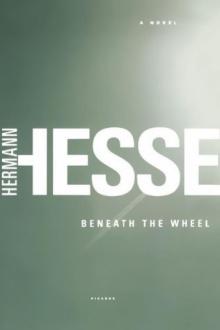 Beneath the Wheel
Beneath the Wheel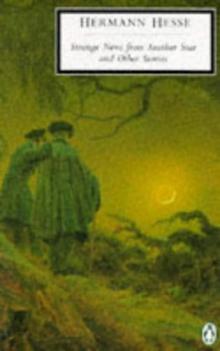 Strange News From Another Star
Strange News From Another Star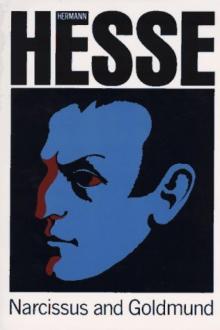 Narcissus and Goldmund
Narcissus and Goldmund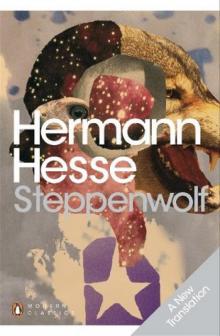 Steppenwolf
Steppenwolf Siddhartha
Siddhartha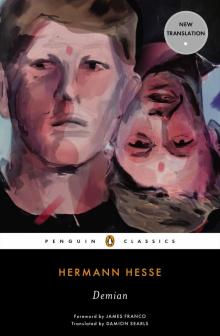 Demian
Demian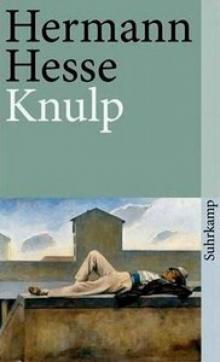 Knulp
Knulp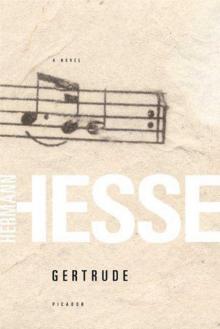 Gertrude
Gertrude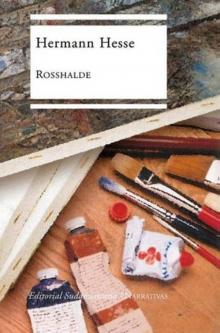 Rosshalde
Rosshalde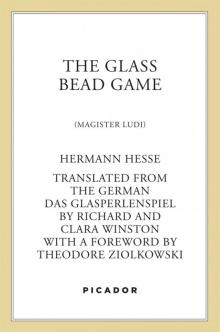 The Glass Bead Game
The Glass Bead Game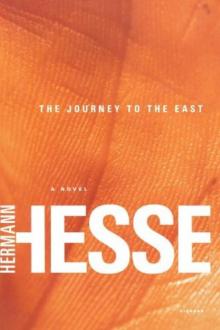 The Journey to the East
The Journey to the East Klingsor's Last Summer
Klingsor's Last Summer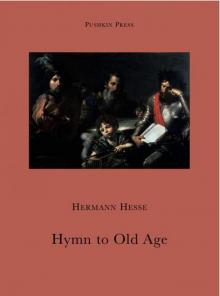 Hymn to Old Age
Hymn to Old Age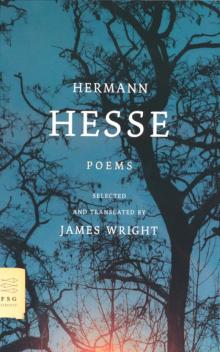 Poems
Poems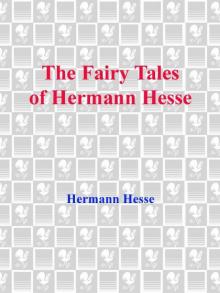 The Fairy Tales of Hermann Hesse
The Fairy Tales of Hermann Hesse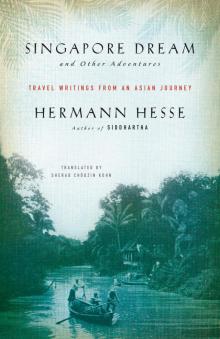 Singapore Dream and Other Adventures
Singapore Dream and Other Adventures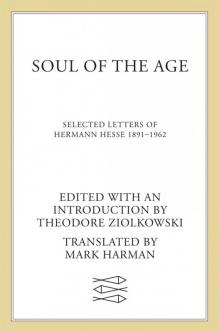 Soul of the Age
Soul of the Age